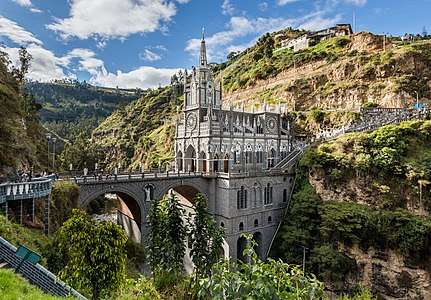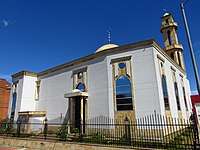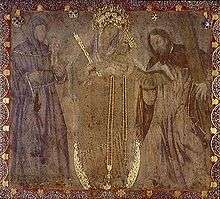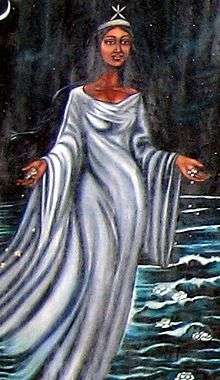Religion in Colombia
Religion in Colombia is dominated by various forms of Christianity and is an expression of the different cultural heritages in the Colombian culture including the Spanish colonization, the Native Amerindian and the Afro-Colombian, among others.[2]
Religion in Colombia (The World Factbook 2014)[1]
Pre-Columbian period
Religious freedom
The Colombian Constitution of 1991 abolished the previous condition of the Roman Catholic Church as state church, and it includes two articles providing for freedom of worship:
- Art. 13: States that "all people are legally born free and equal" and that they will not be discriminated on the basis of "sex, race, national or familial origin, language, religion, political or philosophical opinion".
- Art. 19: Which expressly guarantees freedom of religion. "Freedom of religion is guaranteed. Every individual has the right to freely profess his/her religion and to disseminate it individually or collectively. All religious faiths and churches are equally free before the law."
Catholic Christianity

Christianity (Catholicism) was the official religion of the country from the Spanish colonization until the 1991 constitutional reform (National Constituent Assembly), which granted egalitarian treatment from the government to all the religions. However, Catholicism is still the main religion in Colombia by number of adherents, with an estimated 70% of the national population in nominal Catholicism, from which about 25% are practicing Catholics.
In the colonial period, the Catholic Church was created and in charge of most of the public institutions, such as teaching facilities (schools, colleges, universities, libraries, botanical gardens, astronomical observatories); health facilities (Hospitals, nurseries, leper hospitals) and jails. It also "inherited" a huge amount of land, approx. 1/4 of all the productive land, which was later acquired by the government.
Colombia is often referred as the "Country of the Sacred Heart", due to the annual consecration of the country to the Sacred Heart of Jesus in a Te Deum directed by the president of the republic. Colombia has been re-consecrated to the Sacred Heart of Jesus and consecrated to the Immaculate Heart of Mary in 2008, in a country-wide ceremony celebrated by the main bishops and with the presence of the Colombian president (also a Catholic).
Protestant Christianity
Protestantism, primarily Evangelicalism, now represents 13% of the Colombian populace, and is growing faster than the national growth rate. "Evangelicos" (as they are called in Colombia) hold to the authority of the Bible. Many of them belong to Pentecostal churches, but other churches are active as well.
Bahá'í Faith
The Bahá'í Faith in Colombia begins with references to the country in Bahá'í literature as early as 1916,[4] with Bahá'ís visiting as early as 1927.[5] The first Colombian joined the religion in 1929[6] and the first Bahá'í Local Spiritual Assembly was elected in Bogotá in 1944[7] with the beginning of the arrival of coordinated pioneers from the United States and achieved an independent National Spiritual Assembly in 1961.[8] By 1963 there were eleven local assemblies.[9] In the 1980s institutions were developed in Colombia that have influenced activities inside and independent of the religion in other countries: FUNDAEC[10][11] and the Ruhi Institute.[12] The Association of Religion Data Archives (relying mostly on the World Christian Encyclopedia) estimated some 68,000 Bahá'ís (0.2% of the population) in 2005.[13]
Islam

Approximately 100,000 adheres to Islam according to some.[14] There are a number of Islamic organizations in Colombia, including Islamic in San Andrés, Barranquilla, Bogotá, Guajira, Nariño, and Santa Marta. There are also primary and secondary Islamic schools in Bogotá and Maicao. Maicao plays host to the continent's third largest mosque, the Mosque of Omar Ibn Al-Khattab. Most Muslims in Colombia are either of Arab or Madurese descent.
Other religious affiliations
Various denominations have their own statistics:
- Seventh-day Adventist Church: 270,256 members as of June 30, 2017[15][16]
- The Church of Jesus Christ of Latter-day Saints: 193,350 members (2016)[17]
- Jehovah's Witnesses: about 165,089 members (2015)[18]
- Bahá'í Faith: about 68,000 (2005)[13]
- Judaism: between 5,000 and 10,000 members
- Buddhism: approximately 9,000
Although the government does not keep official statistics on religious affiliation, a 2010 limited survey found[2]
- 70.0% Catholic
- 0.9% Charismatic Catholic
- 14.4% Evangelical Christian
- 1.6% Pentecostal
- 0.3% Charismatic Evangelicals
- 0.4% Protestant
- 2.5% Agnostic
- 2.2% Atheist
- 3.5% Theistic but no religion
- 1.3% Jehovah's Witnesses
- 0.5% Adventist
- 0.1% Muslim
- 2.2% no response
As of 2013, there seems to be no social controversy or problem arising from religious conflict. Religious discrimination is prohibited by the constitution and there is no official religion; however, the state is also explicitly not supposed to be indifferent to religious sentiments and the Catholic church has a special status.[14] All cities and towns in Colombia have a church, but there are also some temples, mosques and synagogues in the largest cities.
A Colombian-grown Taoist movement has spread significantly in recent years. In the 2000s, temples and congregations were target of a paramilitary repression whose motivations are still unclear.[19] Entire Taoist communities were massacred and leaders kidnapped.[19]
In 2008 Taoist communities organised and participated to various peaceful protests in some cities of Colombia.[20]
Religious statistics
The National Administrative Department of Statistics (DANE) does not collect religious statistics, and accurate reports are difficult to obtain. However, based on various studies and a survey, about 90% of the population adheres to Christianity, the majority of which (70.9%) are Roman Catholic, while a significant minority (16.7%) adhere to Protestantism (primarily Evangelicalism). Some 4.7% of the population is atheist or agnostic, while 3.5% claim to believe in God but do not follow a specific religion. 1.8% of Colombians adhere to Jehovah's Witnesses and Adventism and less than 1% adhere to other religions, such as Islam, Judaism, Buddhism, Mormonism, Hinduism, Indigenous religions, Hare Krishna movement, Rastafari movement, Orthodox Catholic Church, and spiritual studies. The remaining people either did not respond or replied that they did not know. In addition to the above statistics, 35.9% of Colombians reported that they did not practice their faith actively.[2][3][21]
While Colombia remains a mostly Roman Catholic country by baptism numbers, the 1991 Colombian constitution guarantees freedom of religion and all religious faiths and churches are equally free before the law.[22]
Syncretism in Colombia
Some syncretic or native religious figures in the country are: The healing ghost of José Gregorio Hernández, the Purgatory souls (Animas del Purgatorio), the Lonely Soul (Anima Sola), the Powerful hand, the Black Christ of Buga, Valle del Cauca, 20 July Baby Jesus (Divine Infant Jesus), Father Marianito (beatified Mariano de Jesus Euse Hoyos 1845–1926),[23] the fertility rites of St Isidro and local variations of syncretism from other countries, such as Santería and Maria Lionza cult.[24]
Gallery
 The Black Christ Icon in the Basilica of Señor de los Milagros (Buga, Valle del Cauca) is visited by thousands of people every week
The Black Christ Icon in the Basilica of Señor de los Milagros (Buga, Valle del Cauca) is visited by thousands of people every week Our Lady of the Rosary of Chiquinquirá (16th century). Virgin de Chiquinquirá is the patroness saint of Colombia. Chiquinquirá is a major point of religious pilgrimage
Our Lady of the Rosary of Chiquinquirá (16th century). Virgin de Chiquinquirá is the patroness saint of Colombia. Chiquinquirá is a major point of religious pilgrimage- Virgin of Rosary in las Lajas Cathedral
 Pilgrims visit Monserrate and the "Saint Christ Fallen by the whips and nailed into the Cross" Icon in Bogotá
Pilgrims visit Monserrate and the "Saint Christ Fallen by the whips and nailed into the Cross" Icon in Bogotá The Anima Sola (lonely soul) often interpreted as a soul in purgatory
The Anima Sola (lonely soul) often interpreted as a soul in purgatory Virgin of Regla is the syncretic form of Yemaja
Virgin of Regla is the syncretic form of Yemaja
See also
References
- "CIA – The World Factbook – Colombia". Cia.gov. Retrieved 27 April 2020.
- Cely, Beltrán; Mauricio, William (2013). Del monopolio católico a la explosión pentecostal’ (PDF) (in Spanish). Universidad Nacional de Colombia, Facultad de Ciencias Humanas, Centro de Estudios Sociales (CES), Maestría en Sociología. p. 101. ISBN 978-958-761-465-7. Archived from the original (PDF) on 27 March 2016.
- Cely, Beltrán; Mauricio, William (2012). "Descripción cuantitativa de la pluralización religiosa en Colombia" (PDF). Universitas humanística. 73. pp. 201–238. Archived from the original (PDF) on 29 March 2014. Based on a 2010 survey in “major cities throughout the country, many mid-size cities, and the rural region of Uraba”.
- `Abdu'l-Bahá (1991) [1916-17]. Tablets of the Divine Plan (Paperback ed.). Wilmette, Illinois, USA: Bahá'í Publishing Trust. pp. 91–92. ISBN 0-87743-233-3.
- Universal House of Justice; prepared under the supervision of the Universal House of Justice. (1986), "In Memoriam", The Bahá'í World, Bahá'í World Centre, XVIII: 733–736, ISBN 0-85398-234-1
- "Around the World; Colombia". Bahá'í News (577): 19. April 1979.
- "South America". Bahá'í News. No. 169. July 1944. p. 7.
- Lamb, Artemus (November 1995). The Beginnings of the Bahá'í Faith in Latin America:Some Remembrances, English Revised and Amplified Edition. 1405 Killarney Drive, West Linn OR, 97068, United States of America: M L VanOrman Enterprises.CS1 maint: location (link)
- The Bahá'í Faith: 1844–1963: Information Statistical and Comparative, Including the Achievements of the Ten Year International Bahá'í Teaching & Consolidation Plan 1953–1963. Haifa, Israel: Hands of the Cause Residing in the Holy Land. 1963. pp. 16, 19, 77.
- CRECE: Centro de Estudios Regionales, Cafeteros y Empresariales (August 2001). "Successful Alternatives for Rural Education: Tutorial Learning System (TLS) and New School Methodology Rural Post-Primary". Regional Policy Dialogue on Education and Human Resources Training Network, Second Meeting: Secondary Education. Manizales, Colombia: Inter-American Development Bank. Retrieved 5 May 2008.
- "Canada - Association's 8th annual Conference". Bahá'í News. No. 634. January 1984. pp. 8–10. ISSN 0195-9212.
- "The World; Honduras". Bahá'í News. No. 648. March 1985. p. 15. ISSN 0195-9212.
- "Most Baha'i Nations (2005)". QuickLists > Compare Nations > Religions >. The Association of Religion Data Archives. 2005. Retrieved 4 July 2009.
- "International Religious Freedom Report for 2015: Colombia". US State Department. Retrieved 6 December 2016.
- http://www.adventistdirectory.org/ViewAdmField.aspx?AdmFieldID=CLUC Retrieved July 2, 2018
- http://adventistdirectory.org/ViewAdmField.aspx?AdmFieldID=SOCO Retrieved July 2, 2018
- "LDS Statistics and Church Facts | Total Church Membership". Mormon Newsroom. Retrieved 6 December 2016.
- 2016 Yearbook of Jehovah's Witnesses (PDF). 2016. Retrieved 6 December 2016.
- "Tao Community in Colombia". 27 October 2009. Archived from the original on 27 October 2009. Retrieved 19 August 2016.CS1 maint: BOT: original-url status unknown (link)
- keliumzeus (15 March 2008). "Marcha TAO. Marcha en la Capital Colombiana. CARACOL". Retrieved 19 August 2016 – via YouTube.
- "Latinobarómetro 1995 - 2017: El Papa Francisco y la Religión en Chile y América Latina" (PDF) (in Spanish). January 2018. Retrieved 30 August 2018.
- Colombian Constitution of 1991 (Title II – Concerning rights, guarantees, and duties – Chapter I – Concerning fundamental rights – Article 19)
- http://www.teleantioquia.com.co/TeleantioquiaensuRegion/Norte2005/PadreMarianito.htm Padre Marianito
- CaribbeanInside.com: Cult to Maria Lionza
